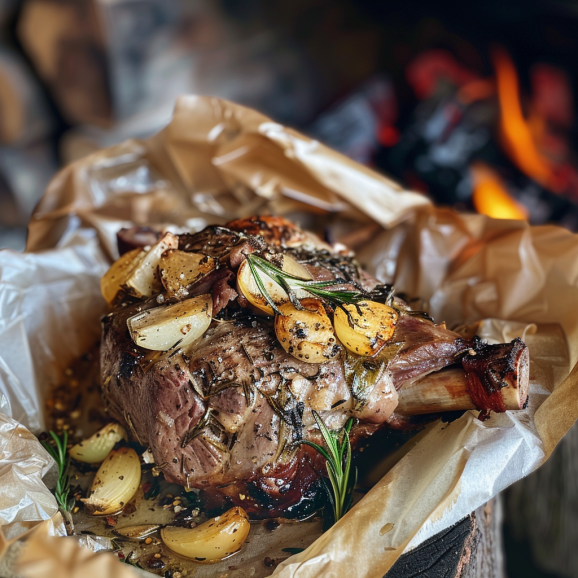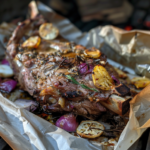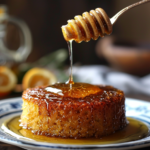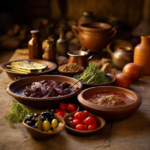
Dive into the heart of Greek cuisine with our Ultimate Guide to Lamb Kleftiko. Learn how to master this traditional dish of tender lamb cooked slowly in parchment paper, complete with chef tips, nutritional information, and perfect pairings.
Introduction Lamb Kleftiko
Introduce Lamb Kleftiko with a brief history of its origins and its cultural significance in Greek cuisine. Highlight the unique aspects of the dish, such as its aromatic seasoning and slow-cooking method that ensures the lamb is succulently tender.
What You Need to Know About Lamb Kleftiko
- History and Origin: Explain the name “Kleftiko,” meaning “stolen meat” and its roots in Greek history.
- Culinary Significance: Discuss its popularity in Greek cuisine and typical occasions it is prepared for.
Ingredients List for Lamb Kleftiko
- Lamb: 2 kg (approximately 4.4 lbs) of lamb shoulder, bone-in, cut into large chunks. Substitution: Boneless lamb shoulder can be used, although bone-in is preferred for extra flavor.
- Olive Oil: 120 ml (about 1/2 cup) of extra virgin olive oil. Substitution: For a lighter version, you can reduce the olive oil or substitute it with another high-smoke-point oil like avocado oil, though this will slightly alter the traditional flavor.
- Lemon Juice: Juice of 2 large lemons. Substitution: If fresh lemons are not available, bottled lemon juice can work in a pinch.
- Garlic: 4 cloves of garlic, minced. Substitution: Garlic powder can be used if fresh garlic isn’t available, use approximately 1 teaspoon.
- Oregano: 2 tablespoons of dried oregano. Substitution: Fresh oregano can be used; if using fresh, increase the quantity to 6 tablespoons, finely chopped.
- Rosemary: 1 tablespoon of dried rosemary. Substitution: Fresh rosemary is a wonderful alternative; use three tablespoons of freshly chopped rosemary.
- Thyme: 1 tablespoon of dried thyme. Substitution: Like rosemary, if fresh thyme is available, use three tablespoons of freshly chopped thyme.
- Salt and Black Pepper: To taste. Typically, about 2 teaspoons of sea salt and 1 teaspoon of freshly ground black pepper.
- Potatoes: 4-6 large potatoes, peeled and quartered. Substitution: Can use other root vegetables like carrots or parsnips for variety or to suit dietary preferences.
- Bay Leaves: 2 bay leaves for added flavor depth. Substitution: If unavailable, you can omit these, but they do add a traditional flavor.
- Feta Cheese: 200 grams (about 7 oz) of feta cheese, crumbled (optional for serving). Substitution: For a dairy-free version, omit the feta or use a vegan cheese alternative.
- Parchment Paper: For wrapping the lamb. No substitution is recommended here as the parchment paper is key to achieving the authentic cooking method that defines Kleftiko.
Lamb Kleftiko Additional Ingredients:
- Red Wine Vinegar: A splash (about 2 tablespoons), for added tanginess in the marinade.
- Water: Approximately 100 ml (about 1/3 cup), if needed, to help create steam within the parchment package, aiding in the cooking process.
This comprehensive list not only outlines what you’ll need to prepare Lamb Kleftiko but also provides options to tailor the recipe to different tastes and requirements, ensuring everyone can enjoy this traditional Greek dish regardless of their dietary needs or ingredient availability.
Step-by-Step Cooking Instructions for Lamb Kleftiko
Step 1: Preparing the Marinade
- Mix the Marinade: In a large mixing bowl, combine the olive oil, lemon juice, minced garlic, dried oregano, rosemary, thyme, salt, and black pepper. Stir well to blend the ingredients.
- Add the Lamb: Place the lamb chunks into the bowl. Toss them thoroughly to ensure each piece is well-coated with the marinade. Cover the bowl with plastic wrap.
- Refrigerate: Let the lamb marinate in the refrigerator for at least 4 hours, ideally overnight. This allows the flavors to penetrate deeply into the meat.
Step 2: Preparing the Parchment Packages
- Preheat the Oven: Preheat your oven to 160°C (320°F). This low temperature is crucial for slow cooking the lamb.
- Prepare the Parchment Paper: Cut large squares of parchment paper enough to create packages that can hold the lamb and its accompaniments.
- Assemble the Packages: On each piece of parchment paper, place a portion of the marinated lamb, a few pieces of quartered potatoes, and a bay leaf. If you’re using red wine vinegar or additional water, add a splash to each packet before sealing.
Step 3: Wrapping and Cooking
- Wrap the Packages: Fold the edges of the parchment paper over the lamb and potatoes, twisting the ends to seal the package tightly. Ensure no steam can escape during cooking.
- Arrange in Baking Tray: Place the wrapped packages on a baking tray. This helps in handling and also catches any drips during the cooking process.
- Bake: Put the tray in the preheated oven and cook for about 2-3 hours. The long cooking time at a low temperature ensures that the lamb becomes exceptionally tender.
Step 4: Finishing and Serving
- Check for Doneness: Carefully open one package to check if the lamb is tender and the potatoes are cooked through. The lamb should be falling apart easily when prodded with a fork.
- Serve: Once cooked, open the parchment packages at the table for an impressive presentation. Sprinkle crumbled feta cheese over each serving if desired.
- Garnish and Enjoy: Garnish with fresh chopped herbs like parsley or dill for a burst of color and freshness. Serve hot, directly from the parchment, for an authentic and rustic experience.
Additional Tips:
- Consistent Heat: Ensure your oven does not fluctuate in temperature during cooking. Consistent low heat is key to achieving perfectly tender lamb.
- Resting Time: Let the lamb rest inside the parchment for about 10 minutes after removing it from the oven. This allows the juices to redistribute.
- Serving Suggestion: For a complete meal, serve Kleftiko with a side of Greek salad or a simple yogurt sauce to complement the rich flavors of the lamb.
By following these detailed steps, you will create a Lamb Kleftiko that is not only authentic and flavorful but also showcases the traditional cooking methods of Greek cuisine. Enjoy the process and the delicious results!
Tips and Tricks for Perfect Lamb Kleftiko
- Select the Right Cut of Lamb:
- Opt for shoulder cuts which are ideal for slow cooking, becoming tender and flavorful over the extended cooking time. Bone-in pieces add more flavor, although boneless can be more convenient for some preparations.
- Marination is Key:
- Marinate the lamb for at least 4 hours, though overnight is best. This not only infuses the lamb with more flavor but also starts the tenderizing process, ensuring the meat is succulent and moist.
- Use Quality Ingredients:
- Invest in high-quality olive oil and fresh herbs. The flavor of the oil and the aromatic herbs like rosemary, thyme, and oregano make a significant difference in the final taste of the dish.
- Control the Heat:
- Lamb Kleftiko should be cooked slowly at a low temperature to prevent drying out the meat and to allow flavors to develop fully. A consistent low temperature is essential for the perfect finish.
- Seal the Parchment Properly:
- Ensure the parchment paper is sealed tightly so that steam cannot escape. This steaming effect helps to cook the lamb gently from all sides, keeping it moist.
- Add a Splash of Acidity:
- A little lemon juice or a splash of white wine in the marinade or added just before sealing the parchment packet can brighten the flavors and cut through the richness of the lamb.
- Let It Rest:
- Once cooked, let the lamb rest inside its parchment pouch for about 10 minutes before serving. This allows the juices to redistribute throughout the meat, ensuring it is moist and flavorful when served.
- Check for Doneness with a Thermometer:
- To avoid overcooking, use a meat thermometer to check if the lamb has reached the desired internal temperature of 145°F (63°C) for medium-rare.
- Incorporate Vegetables:
- Alongside potatoes, try adding carrots, onions, or bell peppers into the parchment packet. They will roast in the lamb juices, absorbing all the delicious flavors.
- Serving Suggestions:
- Present the Lamb Kleftiko still wrapped in its parchment at the table, allowing guests to open it themselves. This adds an element of surprise and delight, enhancing the dining experience.
- Experiment with Flavors:
- Feel free to add other Mediterranean spices like cumin or sumac to the marinade to tailor the flavor profile to your taste preferences.
- Pair Wisely:
- Serve Lamb Kleftiko with a side of a fresh Greek salad, some tzatziki sauce, or a simple yogurt dip to complement the rich flavors of the lamb.
By following these tips and tricks, you can elevate your Lamb Kleftiko from a mere meal to a memorable culinary experience, impressing your family and guests with your mastery of this traditional Greek dish.
Lamb Kleftiko Nutritional Overview
Calories: A single serving of Lamb Kleftiko typically contains approximately 400-600 calories, depending on the size of the serving and the amount of olive oil used in preparation.
Protein: Lamb is an excellent source of high-quality protein, with a serving providing about 30-40 grams. Protein is essential for muscle repair and growth, making this dish a good option for a post-workout meal.
Fat: Lamb is relatively high in fat, with a serving containing around 20-30 grams of fat, of which saturated fat can be significant (about 10-15 grams). However, it also provides healthy monounsaturated fats due to the olive oil used in the marinade and cooking process.
Carbohydrates: This dish is relatively low in carbohydrates, with most coming from the potatoes included in the recipe. A serving may contain about 20-30 grams of carbohydrates.
Fiber: Potatoes and the herbs used provide a modest amount of dietary fiber, enhancing digestion and promoting a feeling of fullness.
Vitamins and Minerals:
- Iron: Lamb is a rich source of iron, which is crucial for forming red blood cells and transporting oxygen throughout the body.
- Zinc: This mineral, abundant in lamb, supports immune function and wound healing.
- Vitamin B12: Crucial for nerve function and the production of DNA, B12 is plentiful in lamb.
- Potassium: Provided by the potatoes, potassium helps to maintain normal blood pressure levels.
Lamb Kleftiko Nutritional Benefits
- Heart Health: The olive oil used in Lamb Kleftiko is high in monounsaturated fats, which are known to be beneficial for heart health.
- Anti-inflammatory Properties: The herbs used, such as rosemary, oregano, and thyme, offer anti-inflammatory benefits and can improve digestion.
Considerations
- Calorie Density: Due to its high fat and calorie content, portion control is crucial when enjoying Lamb Kleftiko, especially if you are watching your calorie intake.
- Saturated Fat: The amount of saturated fat can be a concern, particularly for those with heart conditions or high cholesterol. Choosing leaner cuts of lamb or trimming excess fat can help mitigate this issue.
- Sodium: If salt is used liberally in seasoning, the dish can become high in sodium. To reduce sodium intake, use less salt and increase the herbs and spices for flavoring.
Summary
Lamb Kleftiko offers a nutritious meal option rich in proteins, essential fats, and several vitamins and minerals, making it a valuable addition to a balanced diet. However, due to its higher calorie and fat content, it should be consumed in moderation, particularly by those managing their intake for health reasons. Enjoying this dish as part of a balanced diet, complemented with plenty of vegetables and whole grains, maximizes its benefits while mitigating potential health drawbacks.
Lamb Kleftiko Wine Pairing Suggestions
- Red Wine: A robust red wine such as a Greek Agiorgitiko or Xinomavro pairs wonderfully with lamb, as these wines can stand up to the strong flavors and richness of the meat. The tannins in red wine help cut through the fat of the lamb, enhancing both the meal and the wine.
- White Wine: If you prefer white wine, choose a full-bodied white like a Chardonnay or a Greek Assyrtiko. These wines have enough character to complement the bold flavors of the lamb.
- Beer: A dark or amber ale, with its malty sweetness, can be a great match for lamb, especially if the lamb is highly seasoned or spicy.
- Rose Wine: A dry rosé, with its crispness and slight fruitiness, offers a refreshing counterpoint to the richness of the lamb, making it a light but appropriate choice for warmer weather.
- Non-Alcoholic Beverages: For those who prefer non-alcoholic options, a sparkling water with a squeeze of lemon or a dash of pomegranate juice can be refreshing and palate-cleansing.
By thoughtfully choosing what to serve and pair with your Lamb Kleftiko, you can elevate the dining experience, making it not just a meal, but a memorable culinary event. Whether you opt for simple sides or more elaborate pairings, the key is to balance the flavors to complement the star of the show—the lamb.
Supported by Digital Heroes Caffe our initiative breaks geographical barriers, inviting every kitchen to morph into a quaint Greek taverna, resonating with the symphony of flavors, aromas, and the timeless charm of Hellenic hospitality. Join us in celebrating the enduring legacy of Greek gastronomy, and let each recipe be a passage into the heart of Greece’s culinary tradition. Welcome to Chef on a Bike, where every meal is a heartfelt celebration of life, tradition, and shared culinary endeavors.


















